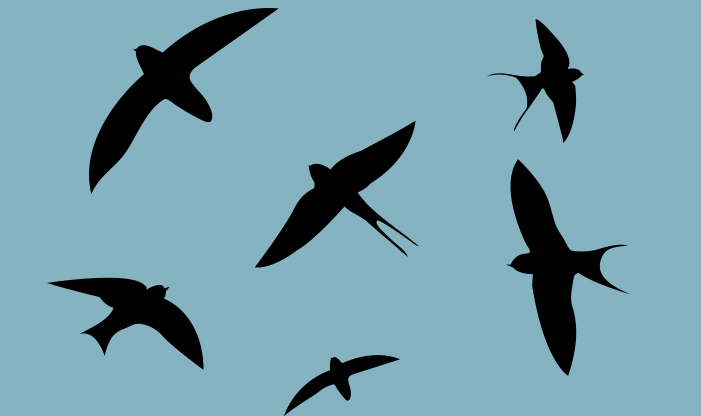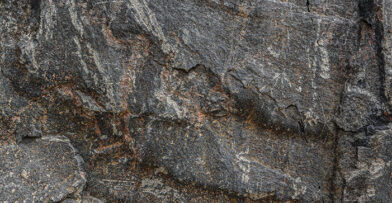Written with contributions from Don Quintenz, Michelle Allison, and Zoe Finney
If you’ve ever seen a large, swirling congregation of birds over a chimney, or the swooping motion of a bird flying close to the surface of a pond, you’ve probably witnessed a species of avian aerial insectivore. Birds that are aerial insectivores hunt and eat insects while they are flying, often displaying stunning flight patterns in the process. While bats and dragonflies also hunt insects in flight, this behavior creates a specialized range of niches for these birds.
Despite individual species of avian aerial insectivores having their primary diet in common, they present a variety of behaviors, are visually distinct, and occupy a diverse array of habitats. Because of this, people can enjoy watching these birds in various habitats around the state and at the Center.
Families of Avian Aerial Insectivores
The four families of birds in this category include swallows, swifts, nightjars, and flycatchers. They are found throughout the Eastern US, with 19 of these species breeding in Wisconsin. All of them are neo-tropical migrants. Many nest in Southeastern Wisconsin through the summer, while others stop over in April and May before migrating further north.
Aerial insectivores have a number of special adaptations that allow them to live within their niche. As a group, their mouths are soft and wide, enabling them to scoop up insects while flying. Wings are often long, pointed, and narrow, giving them the ability to maneuver deftly, and helping them master catching insects.
Three of these families – swallows, swifts, and nightjars – possess many similar traits, while flycatchers display unique capabilities.
Swallows
As a family, swallows mainly eat aquatic insects such as mayflies and stoneflies. There are six species of swallows in Wisconsin, including Barn Swallows, which nest in mud-cake nest cups in the rafters of our Visitor Center. This species will also use nest boxes, and it once nested in caves. Barn Swallows are cobalt blue on top and pale on their breast, with a long forked tail, and you can see them swooping low over our ponds looking for prey. They are the most abundant and widely spread swallow species in the world, breeding throughout the Northern hemisphere.
Tree Swallows nest in cavities and bluebird boxes. Their deep blue iridescent backs and white fronts make them easy to view in summer fields and wetlands, performing aerial acrobatics while catching insects, oftentimes at Mystery Lake. They will form enormous flocks an hour before sunset over their roost sight before they drop and settle in.
The largest of the swallows, Purple Martins live near lakes and ponds and nest near a water source. The males are deep blue with a glossy sheen, and are dazzling to watch while sweeping up insects. They migrate in huge flocks, roosting by the thousands in late summer.
Swifts
As their name suggests, Chimney Swifts roost in chimneys, unable to perch because of their feeble legs. They spend their days flying, and go inside to shelter at night. Swifts became prevalent in the cities during the 1800s when their habitats – caves, cliffs, and hollow trees – were lost to an increase in the number of buildings being constructed. They are often seen in silhouette, and are smudge-grey with long curved wings and a small body, flying almost constantly, even to bathe. Swifts, like swallows, will often hunt in a swarm.
People may see them form large, tornado-like aggregations when the birds are feeding at dawn and dusk. They also can fly to hunt in continuous fashion, often in a zigzag pattern.
Nightjars
Nightjars are known for being strong in the air, but possessing weak legs. The two species in Wisconsin like to sit on logs, where they are well camouflaged. Common Nighthawks are brown with white patches, having long wings and graceful looking flight. They can be identified by their “peent” call. Ranging across North America, they are often seen flying over grasslands and cities – look for them above billboards, stadium lights or streetlights, where they are active at dawn and dusk, often flying like bats.
Another nightjar, the Eastern Whip-poor-will, is often heard making long chant-like sounds in summer. They can be seen hunting on moonlit nights, though they are also active at dawn and dusk, scooping up insects in their large mouth. They breed and roost in gray-brown leaf litter, and can be hard to find because of their excellent camoflauge.
Flycatchers
There are 10 species of flycatcher breeding in Wisconsin. To hunt, flycatchers sally, which means they perch and then fly out to catch insects. Many flycatchers have soft feathers called rictal bristles near their mouths, helping them to grab insects by providing a tactile sense and keeping debris out of their eyes during capture. Having an acute visual ability helps all birds, but flycatchers have vision that’s even better than most. It helps them to catch small, fast-moving insects while in flight. They are forest dwellers who occupy slightly different areas of the woods.
The Great Crested Flycatcher is easy to identify by sight, with distinctive reddish-brown accents and lemon yellow belly. This flycatcher’s call is a rising “wee-eep” whistle that you can hear while it operates high in the canopy of deciduous woods, hunting insects, though it will also eat whole fruit.
An early spring migrant, the Eastern Phoebe’s appearance is considered a sign that spring has arrived. A brown and white songbird with fluffy brown head and white chest, it likes open woodlands and can also be found at Mystery and Turtle Ponds. Its call sounds like its name, “phoebe,” which is quicker and raspier than the similar sounding Black-capped Chickadee call. They make their nests from mud and grass, which you will find on human-built structures at the Center.
Also found at the Center, the Eastern Kingbird prefers grasslands for habitat and nests near the open area of the Lake Michigan Terrace. It’s dark gray on top with a white chest and tip of tail, and a hidden crown of yellow, red, or orange. Kingbirds make an electric-sounding zapping call. This bird species aggressively defends its territory, harassing other birds that get too close. To hunt, They sally or flutter over grassy areas to hunt insects, though they will also eat fruit.
Conservation Status
Many aerial insectivores are doing well and are considered species of low conservation concern, but this varies by species. Some bird species are in decline to steep decline. The Common Nighthawk has lost 80-90% of its population since 1970. Purple Martins are in decline in the Great Lakes region, but stable elsewhere in the country. Chimney Swifts are experiencing loss of habitat as new chimney designs favor smaller flutes unsuitable for nesting, and are actually capped whereas they used to be open.
Challenges to Avian Aerial Insectivores
There are numerous threats to aerial insectivores, but the primary one is the loss of insects, largely due to the increased use of pesticides and insecticides. Climate change has impacted their populations as changing temperatures affect the timing of flying insects’ emergence. There are also problems with an increase in predator populations and habitat loss.
The aerial insectivores are an important part of the ecosystem. They control insects because of their reliance on them for food, and maintain balance in ecosystems by regulating species composition. They also cut down on insect-spread diseases. The primary way we can help as individuals is to help maintain their food source. To do so, avoid using insecticides or pesticides and plant a native garden to attract insects, that may in turn, bring aerial insectivores to your yard.
While you’re visiting the Center this summer, enjoy viewing the avian aerial insectivores. Consider signing up for an evening hiking session to see them up close. You may witness aerial displays that will delight you as they swoop over ponds, sally in the forests, or flutter near nests on the Visitor Center!
Updated to reflect pond name changes.


